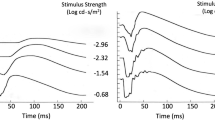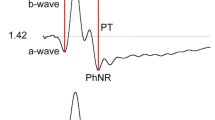Abstract
The Naka-Rushton equation empirically describes the amplitude R of the darkadapted electroretinogram b-wave, as a function of stimulus luminance L, asR/R max = Ln/(Ln +K n). Estimating the three parametersR max,n, andK of this function from electroretinogram data is of both experimental and clinical interest. Several different approaches have been developed to accomplish this analysis, but these approaches may derive different estimates of the three parameters. To examine this possibility, we compared the results of three methods of fitting the Naka-Rushton equation to data sets obtained from 30 normal subjects. Two methods were nonlinear curve-fitting programs; the third method involved fitting a regression line to transformed data. The results indicate that solutions provided by these methods have consistent differences, which may be an important consideration when comparing results reported in studies that used different curve-fitting methods.
Similar content being viewed by others
References
Arden GB, Carter RM, Hogg CR, Powell DJ, Ernst WJK, Clover GM, Lyness AL, Quinlan MP. A modified ERG technique and the results obtained in X-linked retinitis pigmentosa. Br J Ophthalmol 1983; 67: 419–30.
Massof RW, Wu L, Finkelstein D, Perry C, Starr SJ, Johnson MA. Properties of electroretinographic intensity-response functions in retinitis pigmentosa. Doc Ophthalmol 1984; 57: 279–96.
Hood DC. Testing hypotheses about development with electroretinographic and incremental-threshold data. J Opt Soc Am A 1988; 5: 2159–65.
Johnson MA, Hood DC. A theoretical interpretation of ERG abnormalities in central retinal vein occlusion. In: Noninvasive assessment of the visual system. Washington, DC: Optical Society of America, 1988: 84–87 (Technical digest series, Vol. 3).
Birch DG, Fish GE. Rod ERGs in retinitis pigmentosa and cone-rod degeneration. Invest Ophthalmol Vis Sci 1987; 28: 140–50.
Johnson MA, Marcus S, Elman MJ, McPhee TJ. Neovascularization in central retinal vein occlusion: Electroretinographic findings. Arch Ophthalmol 1988; 106: 348–52.
Peachey NS, Fishman GA, Derlacki DJ, Alexander KR. Rod and cone dysfunction in carriers of X-linked retinitis pigmentosa. Ophthalmology 1988; 95: 677–85.
Peachey NS, Gagliano DA, Jacobson MS, Derlacki DJ, Fishman GA, Coher SB. Correlation of electroretinographic findings and peripheral retinal nonperfusion in patients with sickle cell retinopathy. Arch Ophthalmol 1990; 108: 1106–9.
Ikeda H, Ripps H. The electroretinogram of a cone-monochromat. Arch Ophthalmol 1966; 75: 513–7.
Peachey NS, Alexander KR, Fishman GA. The luminance-response function of the dark-adapted human electroretinogram. Vision Res 1989; 29: 263–70.
Aylward GW. A simple method of fitting the Naka-Rushton equation. Clin Vision Sci 1989; 4: 275–7.
Wack MA, Peachey NS, Fishman GA. Electroretinographic findings in human oculocutaneous albinism. Ophthalmology 1989; 12: 1778–85.
Mahler MR, Cordes EM. Biological chemistry, 2nd ed. New York: Harper & Row, 1971: 307–9.
Dwass M. Probability and statistics: A course for undergraduates. New York: Benjamin, 1970: 574–7.
Peachey NS, Alexander KR, Fishman GA, Derlacki DJ. Properties of the human core system electroretinogram during light adaptation. Appl Opt 1989; 28: 1145–50.
Fulton AB, Rushton WAH. The human rod ERG: Correlation with psychophysical responses in light and dark adaptation. Vision Res 1978; 18: 793–800.
Hood DC, Birch DG. A computational model of the amplitude and implicit time of the b-wave of the human ERG Vis Neurosci 1992; 8: 107–26.
Granit R. Sensory mechanisms of the retina. London: Oxford University Press, 1947.
Author information
Authors and Affiliations
Rights and permissions
About this article
Cite this article
Evans, L.S., Peachey, N.S. & Marchese, A.L. Comparison of three methods of estimating the parameters of the Naka-Rushton equation. Doc Ophthalmol 84, 19–30 (1993). https://doi.org/10.1007/BF01203279
Accepted:
Issue Date:
DOI: https://doi.org/10.1007/BF01203279




